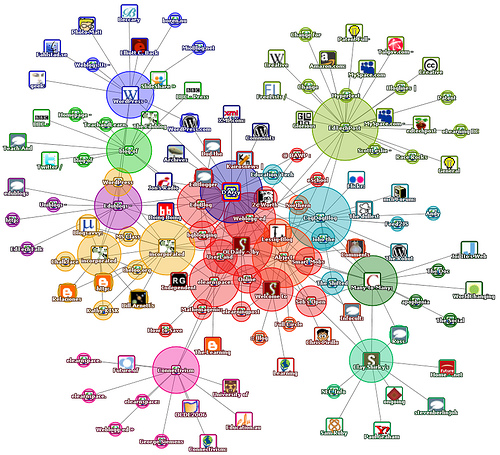Course:ETEC522/2010ST1/InformalLearningEnvironments/FP
4. Future Potential
The Problem
At Startup School 2008,David Heinemeire Hansson said that good innovations come from solving simple problems (Frumar, 2008). Being a learner in many different contexts, but not being able to learn seamlessly and keep learning materials at hand is a real problem that should be solved. PLEs can be a solution to that problem.
Many learners today use powerful personal learning environments. For example, Attwell (2006) uses eighteen different applications in his PLE. Setting up, configuring and maintenance of all this software takes a lot of time and skill. According to Lubensky (2006), only those who are tech-savvy and willing to tinker will try to integrate all those parts of their learning environment. Most learners and teachers probably won’t do that. They are potential users in the emerging market of PLEs. Attwell (2007) has detected the development of a number of applications which provide a framework and tools to facilitate the use and aggregation of different services, such as the open source Flock browser or the ELGG environment. However, a specialized PLE application has yet to be developed, so an open space for future development exists.
According to Attwell (2006), the argument for development of a PLE application is to provide easy access to a range of services, applications and functionality for learners. However, he also points out that there is a danger of creating a new form of the walled garden. To avoid this problem, a PLE application must be easily configured to allow the use of personal tools and applications instead of default settings.
Broader Implications of PLE
Attwell (2007) argues that the development and employment of PLEs would bring about "a radical shift, not only in how we use educational technology, but in the organisation and ethos of education“. Since PLEs give more responsibility and more independence for learners, Attwell (2007) suggests that they would lead to the inevitable change in the balance between institutional learning and learning outside institutions, including informal learning. In such an arrangement, the role teachers and institutions would play is uncertain if learners developed and controlled their own learning environments (Atwell, 2007).
Potential Areas of Applications
Nevertheless, some educational institutions have already started to use PLE. For example, Brighton University in the UK has been providing all students with an ELGG account for their own personal use, independent of curricular activities. It is reasonable to expect that the other educational institutions will use PLEs for their students in the future. But, PLE should not be connected exclusively to a certain institution; it should be linked with a person.
According to Attwell (2007), the New Zealand government has funded a pilot project including nine institutions with aim to integrate the Open Source Moodle VLE and ELGG. „Course based learning outcomes can be exported directly into ELGG, with a single sign on providing access to both systems. One of the big advantages is that the when students move institution they maintain their own ELGG account.”(Atwell, 2007, p. 6)
PLE may be employed by different kinds of institutions for Continuing Professional Development as stated by Attwell (2007) who points out that in large or dispersed institutions there may be little interaction and communication between staff in different departments. According to Attwell (2007), Klagenfurt University has launched a pilot project to integrate ELGG and Moodle for professional development for all staff. Attwell (2007) suggests that PLEs offer considerable potential for knowledge development and sharing in organisational learning.
PLEs could also be employed for self supported and peer group learning. Much of those learning can be considered as informal learning, which is a natural market for PLEs.
Unresolved Issues
In order to conquer the market, PLEs should address many unresolved issues. Atwell (2007) underlines the following issues: who provides technology services, security of data and of the personal safety of students. According to Attwell (2007), one of the major issues is who is controlling and storing data and the reliability of those services. Services could be provided by educational institutions, but that would exclude those who are not currently enrolled in a formal learning programme and who completes their programme and leaves the institution. It could also create problems if a learner was enrolled in programmes at more than one institution. Attwell (2007) considers the creation of a national service offering everyone access to PLE as a solution to that issue.
Lubensky (2006) argues that PLEs used by students dealing with VLEs should interoperate with VLEs. "This requires that VLEs make secure software gateways (eg. APIs) available. It is unlikely that commercial VLEs are willing to distribute their control of the learning environment and provide flexibility, preferring instead to keep users within their proprietary range“ (Lubensky, 2006). However, there have been many open source VLEs, such as Moodle, that might be integrated with PLEs.
Another important issue is intellectual property and the management of digital rights. For example, while articles from subscribed journals may be available in a VLE for enrolled students, does the licence stretch to a PLE (Lubensky, 2006)?
According to Lubensky (2006) PLEs should also resolve the issue of exporting their content in some generic format for safekeeping, especially if the PLE is a web service.
Is there a Future for the PLE?
Schneider (2007) doubts that any company will be able to "corner the market" for PLEs in the near future because there are not standards for exchange of all the personal data from one system to another. On the other hand, Schneider (2007) sees the competition for PLEs from several sides, such as LMSs which may open up to various web services (e.g. Moodle - ELGG integration modules), global service providers like Google (or MS) that provide virtual portals around their own services and better links, references, and document managers (for example, Zotero or Mendeley).
According to Lubensky (2006), it is probable that very soon pilot PLE projects will appear and that publicly-funded PLE projects will be fairly readily accepted. He predicts that PLEs will also be used in higher education where teachers will recommend that students obtain individual licences for these first-generation PLEs although he expects resistance to institutional policy change. Lubensky (2006) argues that this "should kick-start efforts to create gateway APIs and plug-ins into open source VLEs, which can then be mashed in too. This development will be difficult and take considerable time. The success of this integration will be a determining factor in the viability of PLEs as a widely-used product. It will probably take at least three years for a PLE platform to become stable and a critical mass to have the confidence to take advantage of the technology.“
Anderson (2006) argues that "Although there is something quite compelling about the vision of a lifelong learning environment that is centered upon and perpetually belongs to the learner, I think we are some distance from being able to operationalize that vision.“ He thinks that at this stage, PLEs do not enable easy-to-use facilitation and support of many educational functions that are trivial in modern LMS systems. In the future, formal and informal learning opportunities will represent a natural outgrowth of learners' personal computing environments. Although it is not time to discard the LMS just yet, Anderson (2006) suggests that "the PLE future seems to be more secure than that of any monolithic LMS. I suspect the LMS systems that survive will do so by opening themselves to standards based enhancements, service requests and the strong evolutionary move towards real learner centric educational applications.“
Report Card
|
<flash>file=reportcardB.swf|width=200|height=230|quality=best</flash> |
There is an undoubted need for PLEs and specifically for a PLE application. PLEs and PLE applications could be employed in different areas, such as informal learning, institutional (formal) learning, and professional development. Some educational institutions have already started to employ PLEs, which they have connected with institutional LMSs (VLEs). The biggest promise of PLEs is that they could extend access to educational technology to everyone who wishes to organise their own learning. In order to succeed, PLEs should resolve some issues, such as who provides technology services, who secures data, who is responsible for the personal safety of students, connection with VLEs, intellectual property and so on. Possibly the major issues that might impede development of PLEs are the lack of consensus on what PLEs actually are and the inevitable change in the balance between individual learner and educational institutions that PLE might provoke. |
|
Because the brilliant future predicted for PLE might be threatened by the aforementioned unresolved issues, the PLE receives only a B. |
References
Anderson, T. (2006, January 9). PLE’s versus LMS: Are PLEs ready for Prime time? [Web log]. Retrieved from http://terrya.edublogs.org/2006/01/09/ples-versus-lms-are-ples-ready-for-prime-time/
Attwell, Graham (2006, June 1). Personal Learning Environments. Retrieved from http://www.knownet.com/writing/weblogs/Graham_Attwell/entries/6521819364
Attwell, Graham (2007). The Personal Learning Environments - the future of eLearning? eLearning Papers, 2 (1) Retrieved from http://www.elearningeuropa.info/files/media/media11561.pdf
Frumar, J. (2008, April 21). David Heinemeire Hansson at Startup School 08 [Video file]. Retrieved from http://www.omnisio.com/startupschool08/david-heinemeier-hansson-at-startup-school-08
Lubensky, R. (2006, December 18). The present and future of Personal Learning Environments (PLE). Retrieved from http://www.deliberations.com.au/2006/12/present-and-future-of-personal-learning.html
Schneider, D.K. (2007). Personal learning environment. Edutech Wiki. Retrieved 5 July 2010 from http://edutechwiki.unige.ch/en/Personal_learning_environment
Photos and Graphic Data
Norman, D. (2008). [A map of links]. My PLE, according to Google and TouchGraph.com. Retrieved from http://www.flickr.com/photos/dnorman/2314258583/
ICAL. (n.d.) [Illustration]. Retrieved from http://www.icalweb.com/cms/index.php?option=com_content&view=article&id=22&Itemid=311
Next: Report Card
Previous: Total Cost of Ownership (TCO)


